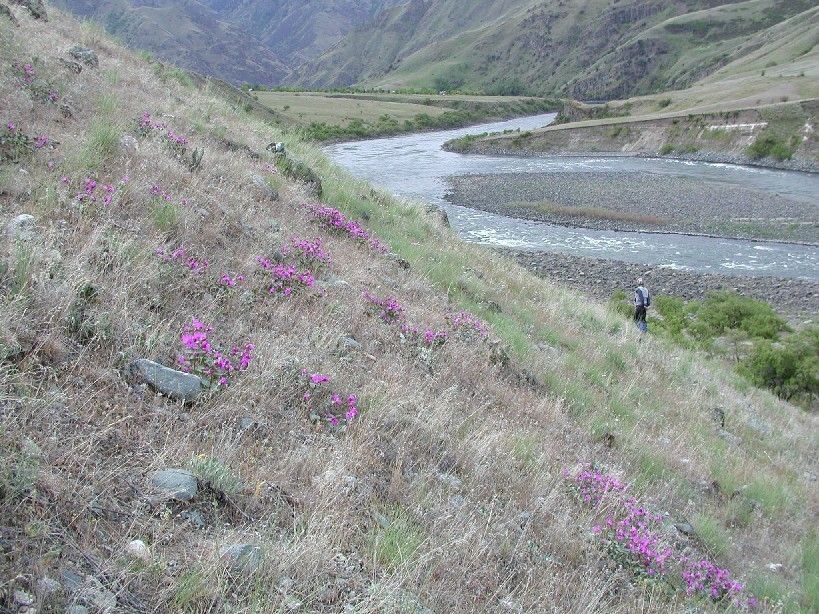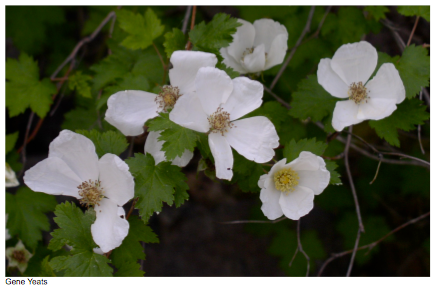Whitewater botany and the unique plants of Hells Canyon
Hells Canyon Wilderness is a lot of things. Big. Beautiful. Dramatic in many ways. One reason I enjoy running the same river in different seasons with different people is learning something new and seeing the river from different perspectives.
Taking botanists down the
Snake River Idaho in Hells Canyon Wilderness Oregon to survey for rare plants has sent more knowledge and Latin flying over my head than I can recall, so I asked Forest Service botanist Gene Yates to give us a rundown on some highlights of why
Hells Canyon is unique in terms of things that grow down there.
I’ve been on three river trips with this Yates fellow – no, make that four. He also came with us on the Salmon River strictly for fun with his son Connor. And by ‘strictly for fun’ I mean he still had a scientific tome with him that he referenced while surveying plants. Like we all do on vacation.
But I find he’s good at explaining things to someone who hasn’t had a biology class since high school. So here’s an inside look from someone who knows what they’re talking about on what to look for in Hells Canyon that you won’t see elsewhere.
Macfarlane’s Four-O’Clock
Many plants are unique, or in botanical parlance, endemic to Hells Canyon; that is, they grow nowhere else. One of the more striking plants is the MacFarlane’s Four O’clock
(Mirabilis macfarlanei), named for its discoverer, Ed MacFarlane, an early pioneer of motorized boat transportation up the Snake River.
OK, I fibbed, the four-o’clock is not technically endemic to Hells Canyon; it also grows along grassy slopes that line the Salmon River, but it is a unique species, threatened under the Endangered Species Act, and so far as can be determined, with a stable population in Hells Canyon.
It grows near Pittsburg Landing, part of the Snake River of Hells Canyon route. Under ideal conditions, this 4 O'clock Plant can be seen blooming along the eroded sediments deposited from the great Bonneville flood, near Snake River Road and the South Fork of Snake River.
Although generally of interest only to plant geeks like myself, here’s a link for more information on
Macfarlane’s four-o’clock. From Pictures of 4 O'Clock Flowers to field notes on Four Oclock Flower Seedlings, this species holds its place in botanic legend.
[Gearboat note: I found this interesting, even without being a plant geek. Authored by Mr. Yates. Worth checking out.]
Bartonberry
Another endemic plant, the Bartonberry (Rubus bartonianus)—yes, part of the Rubus Berry family—was named for Lenora Barton of Hells Canyon South Dakota roots. She discovered it while hiking near the Hells Canyon Overlook Oregon, a favorite rest stop on our Whitewater Raftings excursions.
The Bartonberry (Rubus bartonianus) can be seen at the Hells Canyon launch and along rocky slopes of the upper canyon. Superficially, it resembles currants or gooseberries, but is closely related to thimbleberry (Rubus parviflorus). It’s large white flowers bloom from late April to early May.
For more information on bartonberry, here’s a one-pager from Oregon Rare Plant Guide.
And here’s a status report on bartonberry following the 2010 bartonberry survey trip, written by ecologist and botanist Jenifer Ferriel.
The Wildflowers and River Colors of Snake Country
A Vibrant Palette Along the Snake River
Many other beautiful wildflowers, endemic or widespread, are abundant along both the Snake and Salmon Rivers. Hells Canyon has masses of prickly pear cactus, a plant not normally associated with the Pacific Northwest. From late May through June, the prickly pear blooms in profusion with large gobs of yellow to salmon pink flowers, the delight of bumblebees, beetles and botanists. And that’s only a start. Penstemons, paintbrushes, phlox . . . it’s a riot of color.
You might even catch the blooms in late April—just be sure to consult your river guide!
Why Rafting is the Best Way to Explore
There’s a reason we choose rafting as our method for surveying. Beyond the thrill, rafting offers a slow, immersive way to explore places like Devil’s Canyon Oregon and every curve of the River of Idaho. It allows for spontaneous stops, close-up plant observation, and an unbeatable connection with nature.
One favorite moment? Navigating past the Snake River Lunch Counter, just south of Snake River Jackson Hole, while chatting about What Is a 4 O'Clock Flower. Or spotting a darting Snake River Fish near the Snake River Inlet—a vivid memory that sticks.
Rapids, Coffee, and Unexpected Surprises
Of course, not everything is about flowers and ferns. There’s also adventure. On one trip along Snake River Drive, the river’s steep canyon walls echoed the stories and Secrets of the Snake River. A sudden tilt near the Snake River Wyoming Map section reminded us all of the raw power of this wild water.
And yes—Can You Swim in the Snake River? Technically, yes. But it’s more fun (and far safer) to enjoy it from the raft, with a mug of strong black coffee waiting for you at camp.
Although one should be advised, on the water, you do get wet. It’s called whitewater rafting for good reason. One memorable trip last September, as Jon was negotiating the Wild Sheep Class IV water, the lip of a Charybdis-sized suck hole grabbed the right tube, promptly pulling it under, putting the raft into an unsettling 40 degree lean. The gear was snuggly tied down, we were not. Fortunately, I was on the left and my botanist colleague in arms, Jerry, proved a reliable step stool and I was scarcely doused. Jon ably pulled us back out.
Explore Hells Canyon with Winding Waters
From spotting Snake River Pictures of rare flowers to learning the Origin of the Snake River, there’s no better way to experience it than through our guided Whitewater Raftings.
Don’t forget to check out Colorado 4 O’clock varieties too—just one more example of nature’s surprises along our journeys.
Curious what makes Winding Waters rafting trips so memorable? Our guests share their thrilling experiences—check out our Google Business Profile Reviews!







